 Pirates and Privateers Pirates and Privateers
The History of Maritime
Piracy
Cindy Vallar, Editor
& Reviewer
P.O. Box 425,
Keller, TX 76244-0425
    
Books for Pirate Apprentices ~
History

The Big Book of
Pirates
by
Chuck Tessaro
illustrated
by Anatoly Slepkov
Running
Press, 2004, ISBN 0-7624-1624-6,
US $9.98 / CAN $13.95 / UK £8.99
Who are the pirates?
How do they live? What happens
to them? These are some of the
questions this children’s book
explores. The author defines the
various words for pirates and
looks at where pirates prey.
Different types of pirate ships
and how to navigate them are
also discussed. There are short
biographies on Henry Morgan,
Captain Kidd, Mary Read, Anne
Bonny, Blackbeard, Stede Bonnet,
Sam Bellamy, and Bartholomew
Roberts. The book also covers
fictional pirates, shipwrecks,
and piracy today.
The
uninitiated reader will find a
lot of useful details and depth
about piracy here, but not all
the facts are as well researched
as they should be. For example,
the author refers to Marque of
Letters, whereas most historians
and pirate aficionados know
privateers carried Letters of
Marque. Some of the
quartermaster’s duties actually
belong to the boatswain. The
difference between the red flag
and the black one are reversed.
The statement that experts
believe pirates wear earrings to
improve their eyesight is false.
Another problem is that dates
aren’t always provided, which
leaves the reader thinking the
information pertains to all time
periods, when in actuality the
opposite is true.
Unlike
many picture books, the material
is geared for older children who
want more information but still
like wonderful illustrations
that show true pirates. The book
is a good introduction to
piracy, but readers should
consult other books as well.
Review Copyright ©2005 Cindy
Vallar

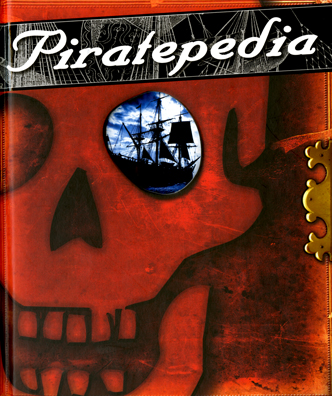
Piratepedia
by
Alisha Niehaus and Alan Hecker
DK
Publishing, 2007, ISBN
978-0-7566-2660-0, US $12.99 /
CAN $15.99
 Travel through
time to visit the history of
piracy. From Ancient Greece to
Scandinavia to the Mediterranean
Sea to France to the Spanish Main
to the South China Sea, readers
learn about pirates, their hunting
grounds, their victims, life at
sea, and the penalties the sea
rogues suffer when captured. Piratepedia
also explores modern maritime
piracy and the swashbucklers of
Hollywood and literature. Maps
locate where you are, while
compasses show you when in time.
Signs and advertisements take you
on side trips and provide you with
tidbits to help you during the
journey. Wanted posters highlight
notorious pirates, while the
"Pirate Times" provides current
events of the day. A poster of
Jack Rackham’s Jolly Roger is also
included. Travel through
time to visit the history of
piracy. From Ancient Greece to
Scandinavia to the Mediterranean
Sea to France to the Spanish Main
to the South China Sea, readers
learn about pirates, their hunting
grounds, their victims, life at
sea, and the penalties the sea
rogues suffer when captured. Piratepedia
also explores modern maritime
piracy and the swashbucklers of
Hollywood and literature. Maps
locate where you are, while
compasses show you when in time.
Signs and advertisements take you
on side trips and provide you with
tidbits to help you during the
journey. Wanted posters highlight
notorious pirates, while the
"Pirate Times" provides current
events of the day. A poster of
Jack Rackham’s Jolly Roger is also
included.
The vivid and
colorful images of artifacts,
ships, weapons, treasure, places,
tools, and food bring the world of
piracy to life. Black-&-white
portraits match the faces of
individual pirates to their names,
allowing readers to observe that
your eyes don’t always see the
evilness beneath the skin.
Although published by the same
company as Eyewitness Books
(Richard Platt’s Pirate is
an example), Piratepedia is
geared toward older children and
is a wonderful resource for
beginning your piratical journey
through history. A rare treat is
the inclusion of historical
tidbits rarely found in other
books on this subject.
One drawback is
that on occasion the authors give
a lopsided view. For example, they
mention that Mediterranean
corsairs – both Christian and
Barbary – enslave people, but
portray the Barbary Corsairs as
villains, whereas the Knights of
Malta come across more as the good
guys. In reality, these corsairs
are sometimes more brutal toward
the many Muslims they enslave than
the Barbary Corsairs are to
Christians. Also, no mention is
made of the fact that Muslims
permitted Christian captives to
convert and be free, or that many
corsairs are renegadoes,
Christians who become Muslims and
attack the ships and towns of
Europe. Someone versed in the
history of pirates will also
discover some facts that aren’t
quite true – such as William Kidd
being captured in New York – but
these are minor infractions.

Sample page
(Source:
Publisher, used with
permission)
The cover is
eye-catching. Through the eye of
the skull one can see a ship
outlined against a cloudy, blue
sky – ripe pickings for any
pirate. Inside is an ominous
warning, “Only the brave or the
foolish dare enter here . . . .”
Both entice readers to delve into
the unsavory world of sea
villains. Several treasures at the
end of the book make Piratepedia
a worthy addition to pirate
collections. Since the authors
include information on piracy
today, readers learn about the
shipwreck discoveries of Sam
Bellamy’s Whydah and
Blackbeard’s Queen Anne’s
Revenge.
Historical collections on sea
rogues do not usually include
excerpts from “Classical Pirate
Literature.” Piratepedia does.
Each selection begins with an
overview of the story and its
importance in piratical history, a
brief biography of the author, and
a list of characters. The pirate
stories included here are Robert
Louis Stevenson’s Treasure
Island, Gilbert and
Sullivan’s The Pirates of
Penzance, and Sir Arthur
Conan Doyle’s Captain Sharkey.
Other authors are mentioned, so
adventurous young pirates can
delve into other noteworthy
stories.
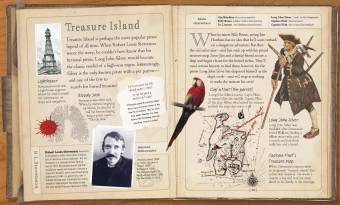
Sample
page
(Source:
Publisher, used with
permission)
Review
Copyright ©2007 Cindy Vallar

 Pirates
Pirates
by John Reeve Carpenter
Sterling, 2008, 978-1-4027-6311-3,
US $9.95 / CAN $10.95
Pirates primarily
focuses on piracy in the early
18th century, the golden age,
but also incorporates other time
periods. The intent is to
separate myth from reality.
Chapter one delves into the
history from ancient times
through the 1800s. The next
chapter examines what life is
like on a pirate ship, from the
social structure to the code of
conduct to living conditions at
sea. Chapter three discusses
battle tactics and weaponry,
while the following chapter
concentrates on types of ships,
Jolly Rogers, and pirate attire.
The last chapter presents a
who’s who of pirates, beginning
with the Barbarossa brothers and
ending with Cheng I Sao. The
book also includes four
appendices: pirate
superstitions, pirate legends,
fictional pirates, and pirate
lore. There is a glossary but no
index.
This is a
beautifully designed book with
wonderful pictures that capture
the imagination or skillfully
illustrate a particular feature
in the text. The pages are the
color of parchment and give the
impression of aged documents.
The fearsome cover art draws the
eye and the sturdy binding will
stand much abuse.
The information is
well organized, neatly arranged,
and absorbing to read. This is
classified as a reference book,
but the lack of an index makes
it difficult to find specific
information without paging
through the book. While the
majority of material presented
in Pirates is a treasure
trove, there are several nuggets
of inaccuracy. For example,
jealousy over Cheng I Sao’s
choice of husband isn’t the
reason for the demise of her
pirate confederation. She
doesn’t remarry until after her
husband dies. A few historians
claim Lauren de Graff is black;
most dispute this claim and
there is no proof to verify the
color of his skin. Keelhauling
is a form of punishment, but not
one pirates of the golden age
use. It is primarily implemented
by navies. The reason for the
large number of men on a pirate
ship isn’t to replace crew
members who died from sickness
or injury, but rather they are
needed to capture and man prize
ships. Gambling, while popular,
is forbidden by many codes of
conduct while on board a pirate
ship because of the conflicts
that can arise. There is no
evidence Blackbeard tortures
captives for sport. Privateers
aren’t licensed to attack
foreign ships rather enemy
ships.
Pirates remains
a treasure as long as readers
don’t rely on it as their sole
source of information on piracy.
Review Copyright
©2009 Cindy Vallar

 Pirates:
Facts, Figures & Fun
Pirates:
Facts, Figures & Fun
by Ian Zaczek
Facts, Figures & Fun,
2007, ISBN 978-1-904332-67-1,
US $5.95 / UK £5.99
Within
the pages of this small
book, Zaczek explores the
realm of piracy during the
16th and 17th centuries,
with particular emphasis on
their activities in the
Caribbean. After a brief
introduction to set the
stage worldwide, he
interweaves facts with
fiction to show readers the
truth about such legendary
pirates as Henry Avery,
Blackbeard, Henry Morgan,
William Kidd, and many
others. He includes
notorious women sea rogues,
as well as pirate hunters.
In the final two chapters,
he examines the image of
pirates and their place in
popular culture. The final
page provides a list of
recommended books and
websites where readers can
find more information.*
One thing to keep in mind is
that this book is a British
publication. This is why
many titles mentioned in the
last chapter are ones with
which Americans probably
won’t be familiar. Also, the
author uses “pressurised”
for “pressured” when talking
about how Kidd's men forced
him into attacking several
vessels. In no way does this
detract; in fact, it
provides readers with a
refreshing examination of
popular culture. Written
primarily for teenagers and
older children, this book is
reminiscent of David
Cordingly’s Under the
Black Flag.
Information about
Blackbeard’s ship, Queen
Anne’s Revenge, is a
tad confusing, only because
the author fails to provide
the original name of the
vessel until four pages
later and the intervening
dates may give the reader
pause. The chart on pirate
trials says fifteen of
Blackbeard’s men are tried
for piracy, but only
provides the outcome for
fourteen of them. These
are minor issues.
This book is a fast
and entertaining read with
oodles of information packed
into ninety-four pages. Its
size is about the same as a
paperback, so it is easily
carried. The chapter on
popular culture includes the
Pirates of the Caribbean
series and Talk Like a
Pirate Day. What I
particularly like is the
tidbits of information not
often found in other pirate
books like this. Pirates:
Facts, Fiction & Fun
is a great introduction to
golden age piracy and a
worthy addition to your
collection, especially if
you’re looking for a brief
overview that will lead you
to further exploration.
*It
is an honor to find Pirates
and Privateers among the
sites listed.
Review Copyright ©2007 Cindy
Vallar

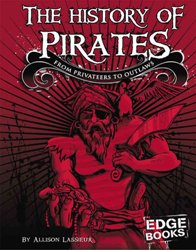 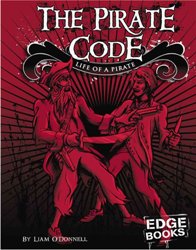 
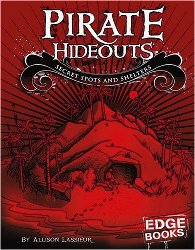 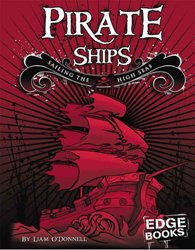  Real
World of Pirates
Real
World of Pirates
The History of Pirates by
Allison Lassieur (ISBN
978-0-7368-6423-7)
The Pirate Code by Liam
O’Donnell (ISBN
978-0-7368-6424-4)
Pirate Gear by Liam
O’Donnell (ISBN
978-0-7368-6425-1)
Pirate Hideouts by Allison
Lassieur (ISBN
978-0-7368-6426-8)
Pirate Ships by Liam
O’Donnell (ISBN
978-0-7368-6427-5)
Pirate Treasure by Liam
O’Donnell (ISBN
978-0-7368-6428-2)
Capstone Press, 2007, US
$23.93 (individual titles)
or US $143.58 (set)
This
new series introduces
pirate apprentices who
read chapter books to the
world of pirates. Each
book is divided into four
chapters that concentrate
on some aspect of the
general topic.
Illustrations and
photographs are captioned,
and a
three-point-introduction
flag begins each chapter.
Special facts are
highlighted on a black
background with white
text, reminiscent of the
pirates’ Jolly Roger. The
books also contain special
features that include a
glossary, suggested
reading list, an index,
and information on how to
access FactHound*, a
safe-for-children internet
site that lists
age-appropriate pirate
websites.
The History of Pirates
examines who they are, how
people become pirates, how
they live, and what
happens to pirates. Much
of the material
concentrates on the golden
age of piracy, but there
are two pages on modern
maritime piracy. The
Pirate Code provides
a closer look at what it
is like to be a pirate. It
includes more details on
becoming a pirate and
their codes of conduct
than History does.
It also includes a page on
women pirates. Pirate
Gear looks at tools
pirates use in battle and
aboard a ship. The final
chapter discusses how
pirates entertain
themselves while at sea. Pirate
Hideouts explores
where the pirates hide and
where they find safe
havens. The book also
looks at the notorious
Port Royal, Jamaica. Pirate
Ships covers ships
and how pirates obtained
them. Pirate Treasure
explains how pirates
search for targets, ways
in which they steal the
treasure, and different
types of booty.
According to
the publisher, the reading
level is grades 3-4 and
the interest level is
grades 3-9. While no
information is provided on
the authors, Sarah Knott,
the Director of the Pirate
Soul Museum in Key West
(now the St. Augustine
Pirate & Treasure
Museum in St. Augustine),
Florida, serves
as the series’ consultant.
A few times, the
generalization of facts do
not quite ring true
because they don’t apply
to pirates throughout
history, but pirate
apprentices just beginning
to learn about pirates
won’t be aware of this. On
the whole, the information
provided is accurate and
the presentation is
absorbing. The interesting
narrative flows from one
page to the next, and the
stunning artwork captures
the reader’s eyes. While
the price is a bit dear,
there are few pirate books
written for pirate
apprentices who have
graduated from picture
books, but aren’t quite
ready for volumes aimed at
older children and young
adults. It is an excellent
introduction to piracy
that may spur pirate
apprentices to investigate
the topic further.
Review
Copyright ©2006 Cindy Vallar

 Ripley’s
Pirates Believe It or Not!
Ripley’s
Pirates Believe It or Not!
by Camilla de la Bedoyere
illustrated by John
Graziano
Ripley Publishing, 2015,
ISBN 978-1-60991-139-3, US
$12.95 / CAN $14.95
Within
the pages of this book
young pirate apprentices
can learn all kinds of
facts about piracy.
Colorful, double-page
spreads cover a wide
array of topics from
famous pirates
throughout history and
around the world to how
to be a scurvy dog and
life aboard a pirate
ship.
The opening pages
explain what readers
will find inside the
book. First, there’s a
table of contents
followed by explanations
of what to look for.
Each entry contains a
brief explanation, and
then youngsters can
explore the various
circles, inkblots,
rectangles, and diagrams
that contain more
information.
"Big
Word Alerts" identify
important words and
their definitions.
"Ripley’s Believe It
or Not! messages"
alert readers to
amazing facts, feats,
and other “wow!”
items. (My favorites
are the pirate ship
sculpture that is
smaller than the eye
of a needle, the
Floridian who builds a
home theater that
looks like the inside
of a pirate ship, and
the father who waves
his teenage son off to
school each morning
wearing a costume.
There are over 170
messages in all.)
"Key Facts" provide
pertinent information
about what’s pictured.
"Twist It! columns"
highlight unbelievable
facts about pirates.
"Lingo scrolls" give
examples of words to
use on International
Talk Like a Pirate
Day. (There are also
suggestions for
creating your own
pirate outfit.)
"Ripley Explains . . .
boxes" include
pertinent information
from pirate experts.
The book
also includes a pirate
newspaper with a few
pirate facts but mostly
tongue-in-cheek
advertisements.
There are some
questionable choices
included in the book.
The "Golden Age of
Pirates" pages include a
square-rigged ship with
three masts even though
the label says that many
pirates sail sloops,
which are smaller
vessels with one or two
masts. Why Mary
Celeste is
pictured is puzzling
since pirates have never
been connected to the
merchant ship whose crew
disappears. The fact
that sailors sometimes
refer to casks of rum as
“Nelson’s blood” only
occurs after 1805 when
Admiral Nelson is killed
during the Battle of
Trafalgar, long after
the golden age of
piracy.
There are a few errors,
too. "Fiibustier" should
be spelled flibustier.
Henry Morgan is the
lieutenant-governor
rather than the governor
of Jamaica. A frigate
carries, at most, fifty
guns instead of the
ninety guns mentioned
under “Types of Sailing
Ships.” Rather than
being placed in
bird-like cages while
alive, captured pirates
are placed in iron cages
after they are dead and
these are made to fit
their corpses.
Ripley’s Pirates
is part of the Twist
series, because readers
sometimes have
to twist the book around
to read some of the
information. Overall,
this hardback book is a
treasure trove of trivia
and facts about pirates
from ancient times to
present day. Young
pirate apprentices aged
seven to eleven will
enjoy exploring all the
pages.
Review
Copyright ©2015 Cindy
Vallar
  Roanoke:
The Mystery of the
Lost Colony
Roanoke:
The Mystery of the
Lost Colony
by Lee Miller
Scholastic, 2007, ISBN
978-0-439-71266-8, US
$18.99 / CAN $22.99
In
1584, two English
ships, guided by a
Portuguese pilot
named Simon
Fernandez, arrive in
the New World. They
seek a place to
claim for Queen
Elizabeth, so that
England can acquire
the same riches
Spain takes from the
Caribbean and
Spanish Main. The
man behind this
expedition and
others is Sir Walter
Raleigh, one of the
queen’s favorites
who feels the best
way to attack Spain
is from the sea.
After all, Spain,
which has the most
powerful navy,
amasses an armada
that will eventually
attack England.
The following year,
another expedition
arrives at Roanoke
Island to establish
a military base. Sir
Richard Grenville
befriends the
Secotan, while John
White draws the
people, flora, and
fauna found in this
country. Grenville
intends to remain
here, but seawater
damages their cargo
and food, so he
returns home. Ralph
Lane refuses to go
with him. He remains
behind to build the
fort. He also wages
war against the
Indians, for he
believes he will
find gold and silver
where the Secotan
acquire their
copper.
Overcrowding in
London and the
beauty and serenity
of the New World
convince John White
to establish a
colony along
Chesapeake Bay. With
Raleigh’s backing
and the queen’s
blessing, he and 117
men, women, and
children set sail in
1587, to establish a
new home. Among the
passengers are his
pregnant daughter
and son-in-law,
Eleanor and Ananias
Dare. Misfortune
plagues the voyage
almost from the
start and their
pilot, Simon
Fernandez, refuses
to take them to
Chesapeake Bay.
Instead, he deposits
them at Roanoke
Island, a dangerous
place because of
Lane’s treatment of
the Indians.
Fernandez’s refusal
to acquire the
needed food and
supplies to survive
the winter forces
White to sail to
England after the
birth of his
granddaughter,
Virginia Dare, the
first white person
born in this New
World. Once there,
circumstances
prevent him from
returning for three
years. Why doesn’t
White return in time
to save his family
and friends? Why
does Fernandez
sabotage the voyage
at every
opportunity? Who
hates White enough
to endanger the
lives of 117
innocent people? Or
is someone else the
actual target and
White and the
colonists are merely
a convenient means
to bring about that
person’s ruin? What
happens to the
colonists and what
does the message
“Croatoan” mean?
Although pirates
play only a
peripheral part in
the story of the
Lost Colony, people
like Walter Raleigh
and Queen Elizabeth
are names well-known
to those who follow
the Sea Dogs who
prey on Spanish
treasure ships and
towns in the 16th
century. Written for
older children,
anyone will find
this narrative of
the events
surrounding the
founding of the
colony and the
colonists’
subsequent
disappearance
fascinating. Miller
incorporates
information from
primary documents
and asks probing
questions that allow
readers to attempt
to unravel the
mystery as they read
the book. While
definitive answers
aren’t available,
the colonists and
others leave clues
to follow and the
narrative provides
readers with a
logical and
comprehensive
understanding of the
circumstances and
people who play
roles in what
happens. Paintings,
drawings, and
photographs,
including White’s
sketches, enhance
the story and make
it more real for the
reader. Roanoke:
The Mystery of the
Lost Colony is
a fascinating look
into the past and an
engrossing
examination of an
unsolved mystery.
Review
Copyright ©2007
Cindy Vallar
 The
Story of Pirates
The
Story of Pirates
by Rob Lloyd Jones
illustrated by
Vincent Dutrait
EDC Publishing,
2007, ISBN
978-0-7945-1618-5,
US $8.99
Part
of the Usborne
Young Reading
series, “which
combines good
stories with
easy reading
text,” The
Story of
Pirates
introduces
readers to the
history of
piracy in six
chapters. The
journey begins
with ancient
pirates, which
includes those
of the Roman
Empire, the
Vikings, and the
Barbary
Corsairs. The
golden age
chapter begins
with the
discovery of the
New World and
talks about life
as a pirate
during the 17th
and early 18th
centuries.
Chapter three
covers pirate
attacks,
covering the
Jolly Roger to
treasure to
articles of
agreement.
“Cruel Captains”
discusses
l’Olonnais and
Blackbeard,
while “Pirates
Defeated” covers
Bartholomew
Roberts and
William Kidd.
The final
chapter touches
on modern
piracy, Asian
piracy, and
pirates in
fiction. The
book closes with
an annotated
list of ten
other famous
pirates and
privateers.
While chapter
one is misnamed,
since it covers
far more than
ancient times,
it is a good
introduction to
key pirates of
the past. While
the author
discusses the
cruelty meted
out on Christian
slaves, he fails
to mention that
Christian
corsairs are
equally brutal
with their
treatment of
Muslim slaves.
There are also
some minor
errors in the
text. For
example, Viking
longships do not
have flat
bottoms. When
repairing leaks
on the hull of a
ship, rotten
planks are
replaced before
oakum and tar
are applied, as
opposed to just
stuffing the
leaks with old
rope and
applying tar.
Blackbeard
wrecks Queen
Anne’s Revenge
before he
battles
Lieutenant
Maynard. William
Dampier does not
maroon Alexander
Selkirk; Thomas
Stradling does.
Overall, the
information
presented is
easy to read and
holds your
attention. What
adds special
panache to the
book are the
color
illustrations.
They vividly
portray pirates
and their lives
at sea in a
realistic
manner. They
bring the text
to life. The
Story of
Pirates is
a good
introduction to
pirates for
early readers
ready for longer
books and for
reluctant
readers. On the
last page within
the fine print,
there is a
website where
readers can go
to learn more
about pirates.
Review
Copyright
©2007 Cindy
Vallar
  Warriors
Warriors
by James
Harpur
Atheneum Books
for Young
Readers, 2007,
ISBN
978-1-4169-3951-1,
US $21.99 /
CAN $26.99
Noble is
the man who
falls in the
front line,
fighting for
his native
land.
-- Tyrtaeus,
Spartan poet*
Throughout
history men
have trained
to be warriors
and have given
their lives to
defend their
homelands, and
sometimes to
conquer new
territories.
Within the
pages of this
oversized book
reminiscent of
John Matthews’
Pirates,
young readers
meet warriors
of the past:
Assyrians,
Spartans,
Alexander the
Great and the
Macedonians,
Celts, Romans,
Gladiators,
Vikings,
Samurai,
Ninja, Genghis
Khan and the
Mongols,
Medieval
Knights,
Aztecs, and
Zulus.
The adventure
begins when
you open the
front cover.
Inside is a
full-color
poster
depicting each
warrior in
traditional
garb and armed
with the
weaponry of
his time. The
double-page
spreads are in
full color on
glossy, heavy
paper that
will survive
many readings.
The pages
combine text
with
artifacts,
maps, weapons,
and spotlights
for each group
of fighters.
Some pages
also have
foldouts, tabs
to pull, and
two groups are
found behind
the closed
gates of their
fortresses.
The Vikings
include a
three-dimensional
image of a
longship,
while the
Ninja have
cards
depicting
stealth
tactics and
the Medieval
Knights have
cards shaped
like shields
that depict
symbols
associated
with these
warriors. The
timeline at
the end of the
book begins
with 753 B.C.
when Rome is
founded, and
ends in 1879
when the
British defeat
the Zulus.
The details,
writing, and
illustrations
provide a
gripping
introduction
to warriors
throughout
history and
the world.
Although
written for
children ages
3-6, adults
will find this
book just as
rewarding and
absorbing. Warriors
will bring
hours of fun
and learning
for the whole
family, and in
the process
spark interest
in exploring
each and every
one of these
warriors
further.
*The
dates given
for this poet
are circa
685-68 B.C.
This would
mean he lived
617 years,
which I doubt.
It is the only
error I found
in the text.
Review
Copyright
©2007 Cindy
Vallar
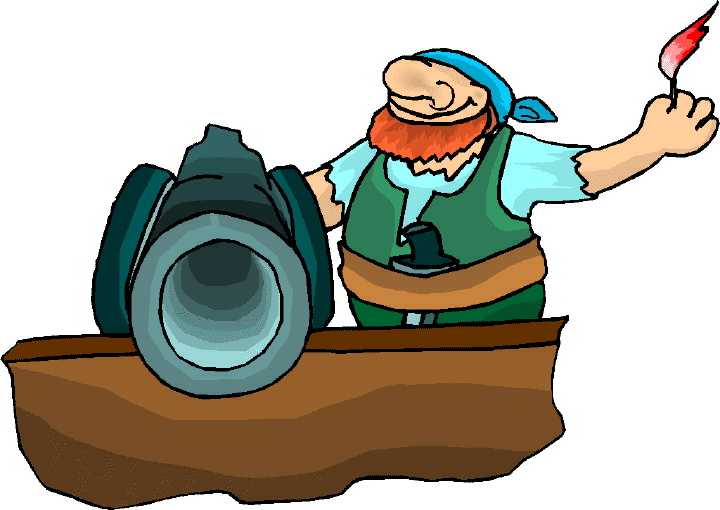
Click to contact me
Background image compliments
of Anke's Graphics |

